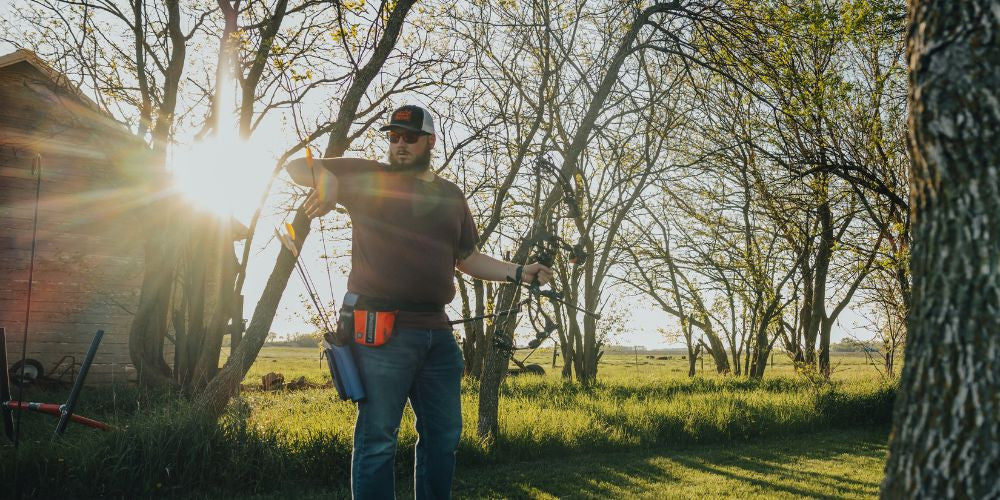From your early days as a marksman, being able to head to an archery range to practice your shots will significantly help you improve your shooting skills and accuracy. However, there are times when you might not readily have access to an archery shooting range. Some ranges are only accessible by car, so you might have difficulty getting to them if you’re not a driver or don’t have access to a vehicle. We also need to remember that there are times when we might not necessarily be in the mood to go out for archery practice - you just want to be alone on some days, right?
For periods when access to a range isn’t possible, you need to be able to improvise and still find ways to train. And fortunately, there are several ways to keep up with your training - some of which might not even involve using your bow and arrow. In this article, we’ll examine some of the best exercises and routines you could perform in place of going out for range shooting.
Bow Shooting Without An Arrow

One of the easiest ways to compensate for the lack of access to a shooting range is to practice with your bow alone. All you have to do is:
- Get a paper target and stick it up a wall - or, if you’d like, you could draw a target on your wall instead
- Stand at a good distance from the target
- Pick up your bow and get into shooting position
- Anchor and draw back your bow as you would normally do
- Settle your bow sight on the target for as long as you accurately can
- Once the sight starts drifting around, slowly release the tension by bringing the bowstring back to its original position and take a break
- Remember to note how long you were able to hold the sight each time to compare your progress later on
- Repeat this sequence about sixty times throughout the week
By practicing with your bow this way, you slowly start to get comfortable aiming without the pressure of shooting.
Note: When conducting this drill, it is important to remember not to dry-fire your bow. This means pulling your bowstring and firing, but without an arrow. Dry-firing can have severe effects - including damage to the bow’s limbs and other bow parts and even injury to yourself.
Archery Band Shooting Exercises

One of the easiest and most cost-effective ways to practice your shooting is to use stretch or resistance bands. While these bands are mostly used for physical therapy, they are also very handy for archers, particularly those with limited training space.
Stretch bands help exercise your muscles and improve both strength and conditioning. This way, you can build muscle stability and improve your draw weight. Since they’re elastic, they also somewhat mimic the feeling of drawing a bow. So, they help you develop consistency in your form and shot process - all without actually touching the bow itself.
With resistance bands, you can perform several exercise routines. Some of them include the following:
Warm-up Routines
Archery bands are a great way to work on your body and get warmed up for a full exercise session. These warmups work your archery muscles, helping you shoot your best and reducing the chance of injury.
With archery bands, you have different warm-up options. They include:
- Spin: Bunch up the stretch band and hold it in your right hand. Then, swing the arm in a large circle while rotating it forward. Rotate it backward as well, then swing your arm in forward circles while crisscrossing your body. Switch to the left arm and repeat.
- Back Stretch: With your arms in a straight position, hold both ends of the band. Keeping your hands at a wider-than-shoulder width apart, take the band over your hand and down behind it. Reach all the way to your lower back as much as you can. Then, return your hands forward to the starting position.
- Circle: With your arms reaching forward, grab both ends of the band while your arms remain a little wider-than-shoulder width apart. Hold the same distance between your hands, then rotate them, so one hand goes around and behind your head while the other follows. Continue rotating in full circles around your body. Then switch directions and go the other way.
The Basic Draw

The name pretty much speaks for itself here. With an archery band, you can properly imitate the process of drawing a bow, thus improving your muscle strength and shot consistency. To perform this exercise, all you have to do is:
- Fold your archery band to create more resistance.
- While grasping one end in each hand, pull the band using the same motion you’d use to draw a bow
- Hold your position for a few seconds
- Repeat this motion 10 to 15 times, pausing at the end of each draw to mimic reaching your anchor point. You can go a total of 3 to 5 sets.
It’s best to use a mirror while performing this routine. One option is to align yourself like the mirror was the target you were aiming at. Shooting from this angle helps you identify issues related to head angle, shoulder alignment, posture, stance, and bow arm position. A second option is to align yourself like the mirror was an archer shooting next to you. This angle helps you identify issues like stance width, hip position, shoulder height, and elbow height.
We recommend switching arms after each set to develop both arms together. Also, while doing this exercise, you want to focus on pinching your shoulder blades together. This way, you can work on your deltoid muscles, latissimus dorsi, and other muscle groups that play roles in the drawing process.
Get A Makeshift Target for Shooting

If you really need to shoot and can’t access an archery shooting range, another option for you will be to get a makeshift target that can help you practice. While you could purchase a target online, there are also simple DIY methods to make a target that won’t cost you so much.
Some DIY target options you could try include:
Hay Bale Target

If you live close to a farm or have access to bales of hay, then you could stack them to create a backstop and print out a target. Place the target in front of the hay bale, and you’ve got something solid.
Generally, hay bale targets are great because they’re affordable and easy to set up. The hay also acts as a backstop, holding your arrow in place once you fire a shot. However, these targets could also present a bit of a challenge regarding maintenance and storage. To maintain the integrity of the hay bales for longer, find somewhere to store the hay when you’re done practicing.
Cardboard Box Target

A cardboard box target could be a good option if you have a good backstop. These targets are very easy to build and are quite durable. To build a cardboard box target:
- Determine the ideal target size and get a cardboard box that fits the dimensions
- Fill the cardboard box with materials that will hold the arrow, such as old clothes, rags, additional cardboard, newspapers, etc.
- Pack the material into the cardboard box and seal it.
- Draw rings on the box, or print out a target and attach it to the box
Bag Targets

Bag targets are probably the simplest archery target to create yourself. They are essentially hanging targets made using a sturdy bag or sack. The main consideration is the appropriate type of filling. To make one:
- Get one or more sturdy burlap sacks or any other durable bag
- Stuff the bag with some backstop material like plastic pallet wrapping, scrap foam or cotton, clothes, or hay.
- Compress the filling to ensure it is dense
- Shut the bag tightly and hang it in your preferred shooting area
Layered Foam Targets

The layered foam target is a great choice for archers that shoot regularly. They hold up well and are more durable than bag targets. While this option might be a bit more expensive, you won’t have to worry about replacing them as often as other cheaper materials.
- Cut your foam sheets into strips or squares
- Arrange the strips or sheets into a stack
- Get two wooden planks and two rods of appropriate lengths to the intended target size
- Drill a hole in the corners of each plank
- Place one plank at the bottom of the target, then fill each corner hole using the rods and screws
- Transfer the stack of foam to the board between the rods. The stack can be as high as needed
- Attach the second plank and tighten the bolts to compress the stack of foam together
- Paint or print your target roundel on the side of the target
To prolong its lifespan, avoid shooting at the same spot on the target each time, and do not leave it outdoors when you’re not practicing.
When making a target, you primarily need to keep two things in mind:
Target Size
Depending on your needs, you will want to consider the target size before building. This also depends on the type of bow you use. Most international competitions have smaller targets for compound bows than recurve bows - although compound bow archers tend to stand closer to their targets.
Standard competition recurve bow targets are typically about 4 feet in diameter with ten target rings. Each ring should measure about 4.7 inches in width. On the other hand, a competition compound bow target usually measures about 2.6 feet in diameter with ten rings. Divided evenly across the target, each ring will measure about 3.15 inches in width.
If you’re not training for a competition, you don’t necessarily need to bother much about these measurements.
Target Weight
You should also consider whether or not you’d like your target to be portable. Generally, you want to be able to pick and move the target by yourself, so it is ideal for long-range shooting as well as close-up practice. This is one area where cardboard box targets seem to have the advantage.
Other materials like wood could also work for targets, although you want to be careful about durability and maintenance.
Conclusion

Consistent practice is one of the most vital aspects of becoming a good archer, hence the importance of an archery shooting range. However, convenience for archery practice is also crucial, and ranges aren’t always readily available. Therefore, complete dependence on professional ranges for practice is not always reasonable.
In situations where you can’t easily access an archery range, you can consider alternative ways to practice your shooting techniques as discussed above - the most crucial consideration being safety for yourself, people, and properties close by.
 cust@legendarchery.com
cust@legendarchery.com 302 503 5767
302 503 5767 Whitestown, In 47075
Whitestown, In 47075




